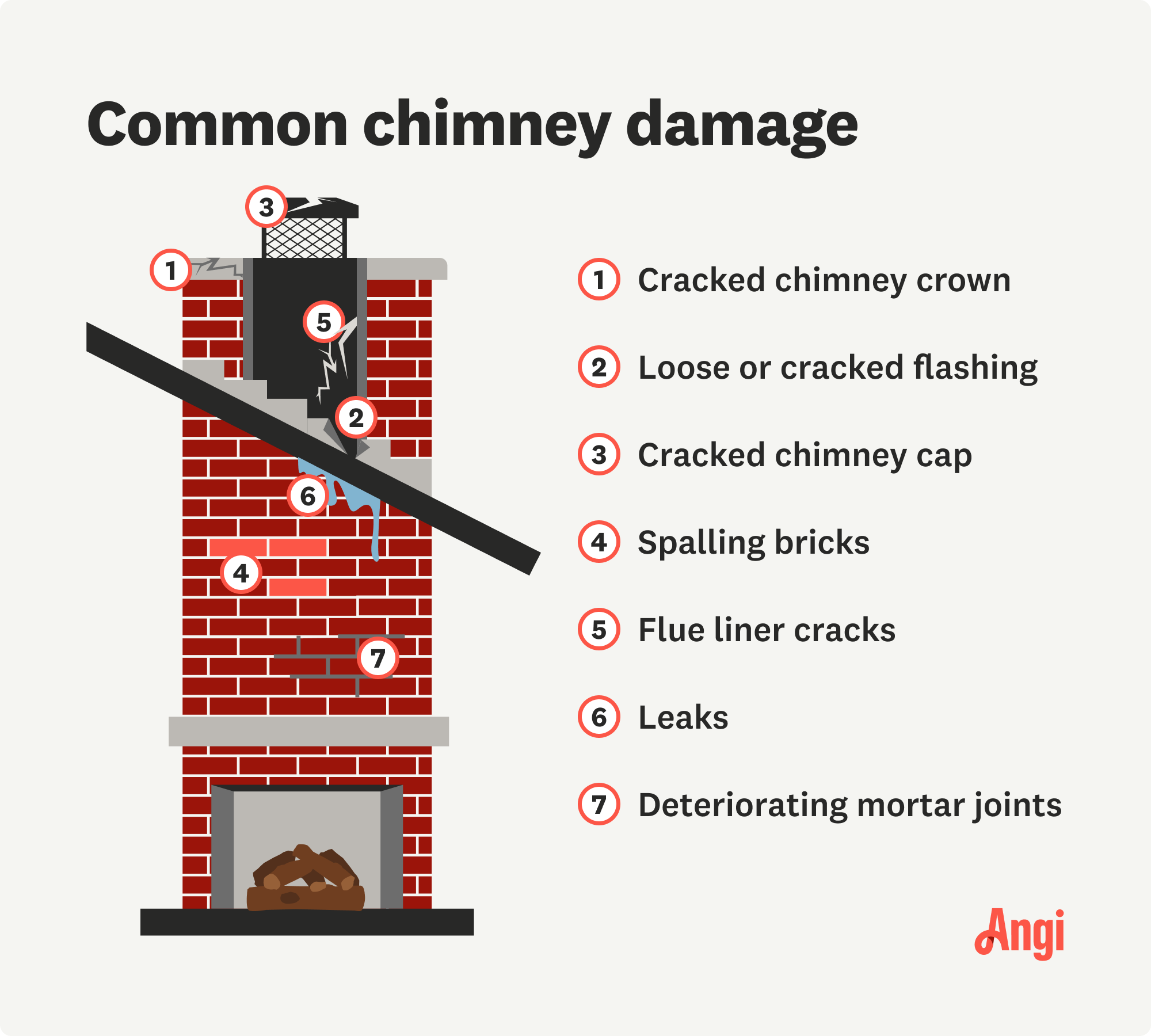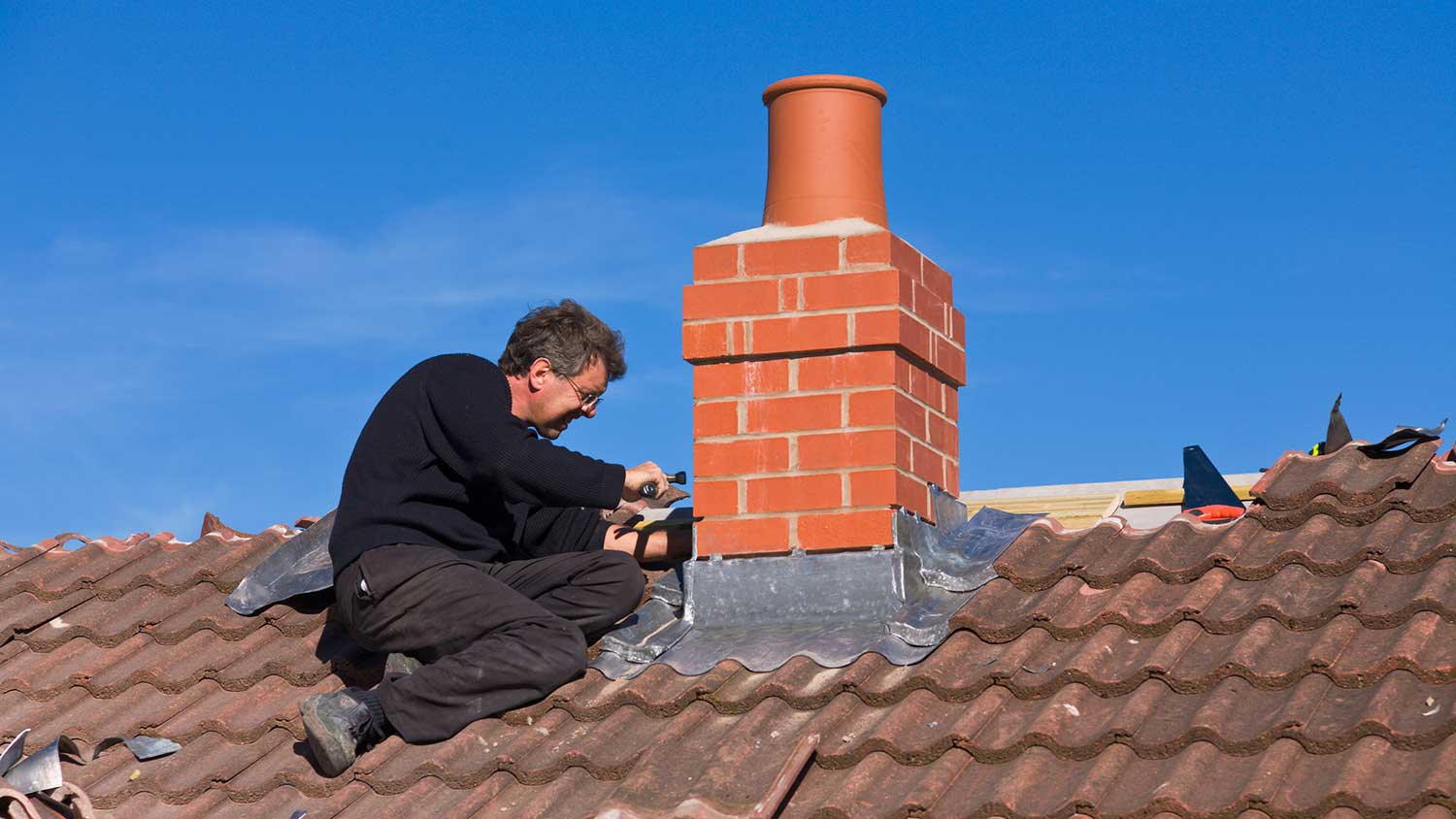
The typical chimney removal costs between $1,000 and $10,000, but much of that price depends on whether it’s a full or partial removal. Get the full cost breakdown here.
If you’ve got more smoke than fire, schedule an inspection


Common chimney repairs include damaged caps, cracked flues, and creosote buildup.
Schedule annual chimney cleanings and inspections to ensure safe burning.
Always consult a local chimney pro for repair recommendations.
The average cost of chimney repairs is $455 while chimney sweeping costs around $250.
Your chimney is the gateway to a relaxing evening by a crackling fireplace—but chimneys aren’t all they’re cracked up to be if they’re not functioning correctly. To keep your chimney functioning as a cozy addition to your home, you’ll need to familiarize yourself with some common chimney problems that can pop up during home inspections.
In this guide, we’ll list the top chimney issues and their solutions so your chimney can remain the safe statement piece it’s always been.

Burning wood in a fireplace creates creosote, a mixture of harsh chemicals the CDC recommends we avoid ingesting. As fireplace smoke condenses, creosote builds up in the chimney liner—first as a soot-like powder, then as a dark brown tar-like substance. Deposits from one or two burns won’t cause much trouble, but excessive buildup over time can become flammable if not appropriately addressed.
Basically, the more buildup, the greater your risk of chimney fire (and not the relaxing, pretty kind, either).
Schedule an appointment with a local chimney sweep once a year to inspect, clean, and maintain your fireplace. The cost of a chimney sweep to perform a level one or two inspection and cleaning—which is usually enough to address creosote buildup—averages $80 to $500.
In addition to creosote blockages, leaves, debris, small animals, and nests can make it hard for smoke to leave the house. When smoke can’t exit properly, it can force carbon monoxide and other toxic fumes back into your home. This can also happen if your chimney is not the right height or size.
Your friendly neighborhood chimney sweep can remove whatever is obstructing the draft. They might also suggest installing a chimney cap to protect your chimney from future blockages. On average, the cost to install a chimney cap is $300.

Brick chimneys are certainly durable, but they’re not indestructible. As your chimney combats moisture, the moisture can crack and crumble after the bricks freeze and expand. Weakened mortar compromises the chimney's stability, which can lean and collapse if you don’t attempt to reinforce it.
First, have a chimney repair pro or mason assess your masonry damage. They can address minor damage with a process called tuckpointing, which replaces old mortar between your bricks with fresh, stronger material. The average cost of tuckpointing is $500 or about $10 per square foot.
However, if your brickwork needs help, your pro might recommend a complete or partial rebuild. A partial chimney rebuild costs $1,000 to $3,000, while a complete one can cost well over $10,000. If you just need to rebuild the chimney stack, budget $150 per linear foot.
Your chimney crown's sole purpose is to protect your chimney from weather exposure. The crown is a metal, concrete, or stone slab that covers the top of your chimney—but it can crack under constant pressure from rain, sleet, snow, and even tree limbs. A damaged crown exposes your chimney parts to moisture and mold, which will weaken the overall structure.
Depending on how early you catch a cracked chimney crown, you might be able to save a few bucks and have it resealed. But you’ll need to replace the crown if it’s missing a few chunks, getting up in age, or sporting some deep cracks.
The cost to repair a chimney crown is:
Repair: $300–$2,200
Reseal: $175–$600
Resurface: $800–$1,200
Replace: $1,800–$3,000

A chimney’s flashing prevents weather like ice and rain from entering your attic. Another home inspection chimney issue is cracked flashing. Older and improperly installed flashing can crack, impairing structural integrity and encouraging mold growth.
When your flashing starts to fail, you might need to repair or replace it. Flashing that has pulled away from the chimney can be repaired, but you’ll need to replace it if the flashing is rusted or eroding. The cost to repair your chimney flashing is $200 to $500. Replacing it can cost up to $2,000.
Perhaps one of the most important chimney components, your flue liner allows smoke to escape safely. If your flue liner is damaged, it can force the smoke and heat to reach your home’s wooden support structures and framing, which is a fire risk.
If you believe your flue liner is damaged, stop using your fireplace and contact a nearby chimney pro. To safely use your fireplace, you’ll need to replace your flue liner, possibly with more durable material—chimney liners cost $2,500 on average. And of course, keeping up with the flue is another great reason to schedule annual chimney inspections.
Your chimney’s cap helps keep it safe from moisture, animals, and debris. If it’s damaged, it can’t protect your chimney as intended, leading to the blockages and breakdowns discussed above.
The best solution for chimney cap damage is to replace it, which typically costs $300.
The cost of chimney repair, like that of many household repairs, varies greatly depending on the extent of the damage. On average, chimney repairs will cost about $160 to $750, though they may go up to several thousand dollars. Cosmetic chimney repairs and those that involve routine masonry maintenance on the exterior of the chimney will be on the lower end of the range. But expect to pay higher costs for large structural issues that impact the integrity of the surrounding areas. Labor costs will also depend on the area you live in.
Creosote is a flammable residue that builds up due to incomplete combustion and can cause chimney fires if not cleaned regularly. Hire a chimney sweep to remove creosote build up at least once per year—or more frequently if you use your fireplace often.
Chimney repair is not a job for a DIYer. Doing repairs incorrectly could end up causing further damage to the bricks or liner, accidental obstructions, or damage to the surrounding areas. You could also make a problem worse that then affects the efficiency of the chimney, risking the health and safety of yourself and your family.
Additionally, working on a roof is dangerous. Chimney professionals have extensive training and experience on how to work on a roof safely. Lastly, you’ll be exposed to ash, creosote, and masonry dust, which is toxic. When it comes to chimney repairs, leave them to a local chimney repair professional.
From average costs to expert advice, get all the answers you need to get your job done.

The typical chimney removal costs between $1,000 and $10,000, but much of that price depends on whether it’s a full or partial removal. Get the full cost breakdown here.

Chimney repair costs can vary by the type of chimney you have and the required repairs. Use this guide to help you estimate project costs.

Replacing your chimney increases home value and prevents hazardous structural damage. Learn how much to budget for chimney replacement costs.

Water coming from around your chimney can be a sign of a serious problem. Learn how to fix a leaking chimney so you can stay on top of the issue.

Ensuring the safety of your house is a homeowner’s primary concern. If you have a fireplace, you need to know “What is a chimney flue?”

Oversized flues lead to chimney corrosion, freeze/thaw damage, and an uncomfortable draft. Here are the standard chimney flue sizes to ensure proper integration.